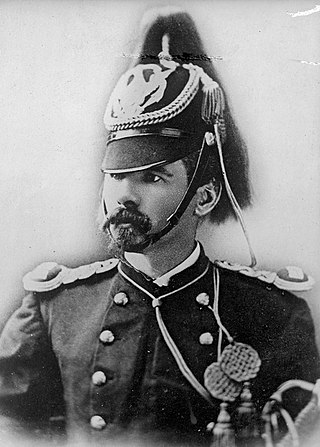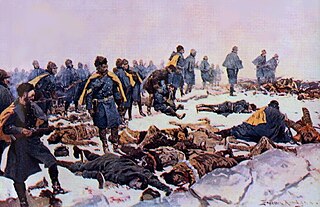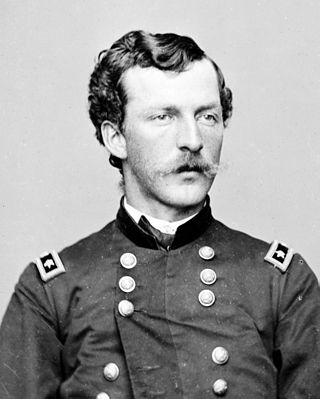
The Battle of the Little Bighorn, known to the Lakota and other Plains Indians as the Battle of the Greasy Grass, and commonly referred to as Custer's Last Stand, was an armed engagement between combined forces of the Lakota Sioux, Northern Cheyenne, and Arapaho tribes and the 7th Cavalry Regiment of the United States Army. The battle, which resulted in the defeat of U.S. forces, was the most significant action of the Great Sioux War of 1876. It took place on June 25–26, 1876, along the Little Bighorn River in the Crow Indian Reservation in southeastern Montana Territory.

Salvatore Mineo Jr. was an American actor. He was best known for his role as John "Plato" Crawford in the drama film Rebel Without a Cause (1955), which earned him a nomination for the Academy Award for Best Supporting Actor at age 17, making him the fifth-youngest nominee in the category.

Crazy Horse was a Lakota war leader of the Oglala band in the 19th century. He took up arms against the United States federal government to fight against encroachment by white American settlers on Native American territory and to preserve the traditional way of life of the Lakota people. His participation in several famous battles of the Black Hills War on the northern Great Plains, among them the Fetterman Fight in 1866, in which he acted as a decoy, and the Battle of the Little Bighorn in 1876, in which he led a war party to victory, earned him great respect from both his enemies and his own people.

The Battle of Bear Paw was the final engagement of the Nez Perce War of 1877. Following a 1,200-mile (1,900 km) running fight from north central Idaho Territory over the previous four months, the U.S. Army managed to corner most of the Nez Perce led by Chief Joseph in early October 1877 in northern Montana Territory, just 42 miles (68 km) south of the border with Canada, where the Nez Perce intended to seek refuge from persecution by the U.S. government.
The Battle of the Tongue River, sometimes referred to as the Connor Battle, was an engagement of the Powder River Expedition that occurred on August 29, 1865. In the battle, U.S. soldiers and Indian scouts attacked and destroyed an Arapaho village.

The Powder River Expedition of 1865 also known as the Powder River War or Powder River Invasion, was a large and far-flung military operation of the United States Army against the Lakota Sioux, Cheyenne, and Arapaho Indians in Montana Territory and Dakota Territory. Although soldiers destroyed one Arapaho village and established Fort Connor to protect gold miners on the Bozeman Trail, the expedition is considered a failure because it failed to defeat or intimidate the Indians.

The Battle of Dead Buffalo Lake was a skirmish in July 1863 in Dakota Territory between United States army forces and Santee, Yankton, Yanktonai and Teton Sioux. The Sioux attempted to capture the pack train of the army and retired from the field when they were unsuccessful.

Myles Walter Keogh was an Irish soldier. He served in the armies of the Papal States during the war for Italian unification in 1860, and was recruited into the Union Army during the American Civil War, serving as a cavalry officer, particularly under Brig. Gen. John Buford during the Gettysburg Campaign and the three-day Battle of Gettysburg. After the war, Keogh remained in the regular United States Army as commander of I Troop of the 7th Cavalry Regiment under George Armstrong Custer during the Indian Wars, until he was killed along with Custer and all five of the companies directly under Custer's command at the Battle of the Little Bighorn in 1876.

American Horse was an Oglala Lakota chief, statesman, educator and historian. American Horse is notable in American history as a U.S. Army Indian Scout and a progressive Oglala Lakota leader who promoted friendly associations with whites and education for his people. American Horse opposed Crazy Horse during the Great Sioux War of 1876–1877 and the Ghost Dance Movement of 1890, and was a Lakota delegate to Washington. American Horse was one of the first Wild Westers with Buffalo Bill's Wild West and a supporter of the Carlisle Indian Industrial School. His record as a councilor of his people and his policy in the new situation that confronted them was manly and consistent and he was known for his eloquence.

American Horse was an Oglala Lakota warrior chief renowned for courage and honor. American Horse is notable in American history as one of the principal war chiefs allied with Crazy Horse during Red Cloud's War (1866–1868) and the Battle of the Little Bighorn during the Great Sioux War of 1876–1877. Chief American Horse was a son of Old Chief Smoke, an Oglala Lakota head chief and one of the last great Shirt Wearers, a highly prestigious Lakota warrior society. He was a signatory to the Fort Laramie Treaty of 1868, along with his brothers Chief Red Cloud and Chief Blue Horse. A month or so after the Treaty, American Horse was chosen a "Ogle Tanka Un" along with Crazy Horse, Young-Man-Afraid-of-His-Horses and Man That Owns a Sword. On September 9, 1876, American Horse was mortally wounded in the Battle of Slim Buttes fighting to protect his family and defending against the white invasion of the "Paha Sapa" Black Hills.

White Bull was the nephew of Sitting Bull, and a famous warrior in his own right. White Bull participated in the Battle of the Little Bighorn on June 25, 1876.

The Battle of Powder River, also known as the Reynolds Battle, occurred on March 17, 1876, in Montana Territory, United States as part of the Big Horn Expedition. The attack on a Northern Cheyenne and Oglala Lakota Indian encampment by Colonel Joseph J. Reynolds initiated the Great Sioux War of 1876. Although destroying a large amount of Indian property, the attack was poorly carried out and solidified Northern Cheyenne and Lakota Sioux resistance to the U.S. attempt to force them to sell the Black Hills and live on a reservation.

Comanche was a mixed-breed horse who survived George Armstrong Custer's detachment of the United States 7th Cavalry at the Battle of the Little Bighorn.

James Ezekiel Porter was one of General Custer's eleven officers killed at the Battle of Little Bighorn, also known as Custer's Last Stand, and Porter was among the first verified casualties of the historic battle alerting the world to the demise of Custer's group. According to several historians, Porter led troops in a defensive action at the Little Bighorn. Porter also served in the American South during the Reconstruction Era, where, according to a comrade, he respectably served "Ku Klux" duty while the 7th Cavalry was charged with eradicating the Ku Klux Klan and illegal distilling.
George Armstrong Custer (1839–1876) was a United States Army cavalry commander in the American Civil War and the Indian Wars. He was defeated and killed by the Lakota, Northern Cheyenne, and Arapaho tribes at the Battle of the Little Bighorn. More than 30 movies and countless television shows have featured him as a character. He was portrayed by future U.S. president, Ronald Reagan in Santa Fe Trail (1940), as well as by Errol Flynn in They Died With Their Boots On (1941).

The Battle of Canyon Creek was a military engagement in Montana Territory between the Nez Perce Indians and the United States Army's 7th Cavalry. The battle was part of the larger Indian Wars of the latter 19th century and the immediate Nez Perce War. It took place on September 13, 1877, west of present-day Billings in Yellowstone County, in the canyons and benches around Canyon Creek.

The Fort Robinson breakout or Fort Robinson massacre was the attempted escape of Cheyenne captives from the U.S. army during the winter of 1878-1879 at Fort Robinson in northwestern Nebraska. In 1877, the Cheyenne had been forced to relocate from their homelands on the northern Great Plains south to the Darlington Agency on the Southern Cheyenne Reservation in Indian Territory (Oklahoma). In September 1878, in what is called the Northern Cheyenne Exodus, 353 Northern Cheyenne fled north because of poor conditions on the reservation. In Nebraska, the U.S. Army captured 149 of the Cheyenne, including 46 warriors, and escorted them to Fort Robinson.
The Big Horn Expedition, or Bighorn Expedition, was a military operation of the United States Army against the Lakota Sioux and Cheyenne Indians in Wyoming Territory and Montana Territory. Although soldiers destroyed one Northern Cheyenne and Oglala Lakota village at the Battle of Powder River, the expedition solidified Lakota Sioux and Northern Cheyenne resistance against the United States attempt to force them to sell the Black Hills and live on a reservation, beginning the Great Sioux War of 1876.
The Yellowstone Expedition of 1873 was an expedition of the United States Army in the summer of 1873 in Dakota Territory and Montana Territory, to survey a route for the Northern Pacific Railroad along the Yellowstone River. The expedition was under the overall command of Colonel David S. Stanley, with Lieutenant Colonel George A. Custer second in command.

The Battle of Little Muddy Creek, also known as the Lame Deer Fight, was fought on May 7–8, 1877, by United States soldiers and scouts against a village of Miniconjou Lakota and Northern Cheyenne. The battle occurred near Little Muddy Creek in Montana Territory, near present-day Lame Deer, Rosebud County.














